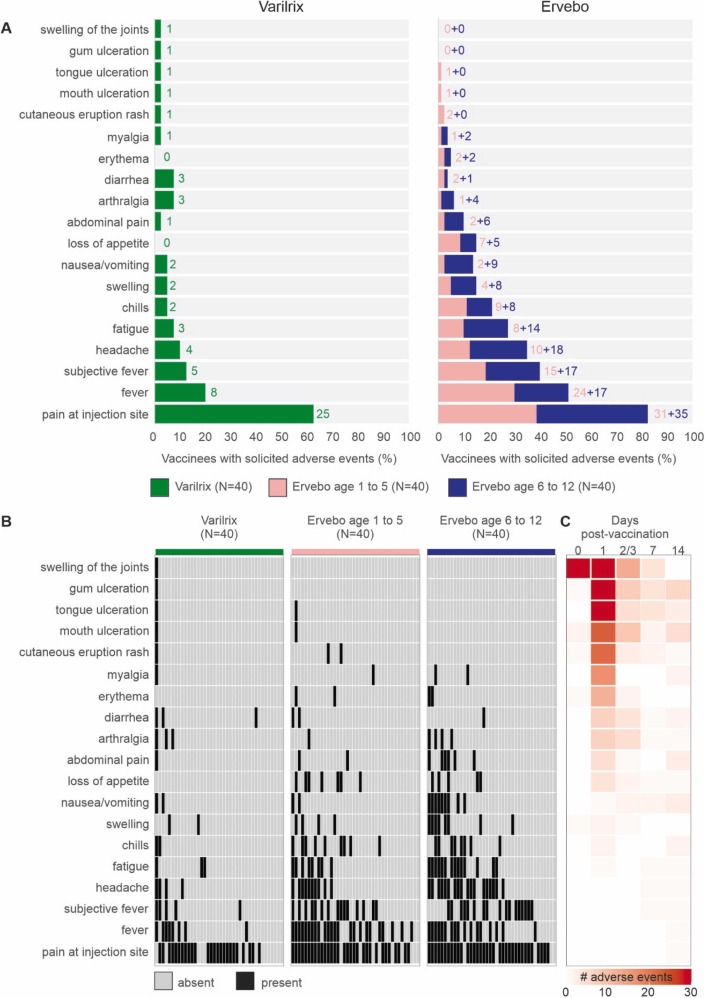Replication, safety and immunogenicity of the vectored Ebola vaccine rVSV-ΔG-ZEBOV-GP in a sub-Saharan African paediatric population: A randomised controlled, open-label trial in children aged 1-12 years living in Lambaréné, Gabon.
BACKGROUND: Unlike adults, children experienced stronger and longer vector replication in plasma and shedding in saliva following rVSVΔG-ZEBOV-GP vaccination. The resulting risks of immunosuppression or immune hyperactivation leading to increased Adverse Events (AEs) and altered antibody responses are concerns that have been addressed in the present manuscript. METHODS: Children aged 1-12 years living in Gabon received either rVSVΔG-ZEBOV-GP (ERVEBO®) vaccine or the varicella-zoster virus (VZV) vaccine (VZV). The concentration of rVSVΔG vector in blood and saliva, the occurrence of AEs up to day 28; the anti-rVSVΔG-ZEBOV-GP and anti-VZV IgG antibody titres, neutralising and avidity functions of anti-rVSVΔG-ZEBOV-GP by day 365; were assessed in serum. (PACTR202005733552021) FINDINGS: In the rVSVΔG-ZEBOV-GP group, 70% and 7% of children had >0 copies/ml of rVSVΔG respectively in plasma by day 3 and in saliva by day 14 after vaccination, with no detection on day 28. Significantly higher but transient AEs occurred in the rVSVΔG-ZEBOV-GP group. Both vaccines induced seroconversion on day 28 and sustainable IgG antibody titres by day 365. Avidity and neutralisation functions of the anti-rVSVΔG-ZEBOV-GP antibodies peaked at day 28 and were maintained by day 365. INTERPRETATION: The replication and shedding do not affect the favourable risk-benefit balance of the rVSVΔG-ZEBOV-GP in children.
Authors
Alabi A, Kokou K, Mahmoudou S, Kavishna R, Nakka SS
External link
Publication Year
Publication Journal
Associeted Project
Microbiology or Immunology
Lista de serviços
-
As antisense RNA gets intronic.As antisense RNA gets intronic.
-
Androgen responsive intronic non-coding RNAs.Androgen responsive intronic non-coding RNAs.
-
Conserved tissue expression signatures of intronic noncoding RNAs transcribed from human and mouse loci.Conserved tissue expression signatures of intronic noncoding RNAs transcribed from human and mouse loci.
-
The intronic long noncoding RNA ANRASSF1 recruits PRC2 to the RASSF1A promoter, reducing the expression of RASSF1A and increasing cell proliferation.The intronic long noncoding RNA ANRASSF1 recruits PRC2 to the RASSF1A promoter, reducing the expression of RASSF1A and increasing cell proliferation.
-
Antisense intronic non-coding RNA levels correlate to the degree of tumor differentiation in prostate cancer.Antisense intronic non-coding RNA levels correlate to the degree of tumor differentiation in prostate cancer.
-
Insight Into the Long Noncoding RNA and mRNA Coexpression Profile in the Human Blood Transcriptome Upon Leishmania infantum Infection.Insight Into the Long Noncoding RNA and mRNA Coexpression Profile in the Human Blood Transcriptome Upon Leishmania infantum Infection.
-
Long non-coding RNAs associated with infection and vaccine-induced immunityLong non-coding RNAs associated with infection and vaccine-induced immunity
-
Comparative transcriptomic analysis of long noncoding RNAs in Leishmania-infected human macrophagesComparative transcriptomic analysis of long noncoding RNAs in Leishmania-infected human macrophages
-
SARS-CoV-2 Selectively Induces the Expression of Unproductive Splicing Isoforms of Interferon, Class I MHC, and Splicing Machinery Genes.SARS-CoV-2 Selectively Induces the Expression of Unproductive Splicing Isoforms of Interferon, Class I MHC, and Splicing Machinery Genes.

